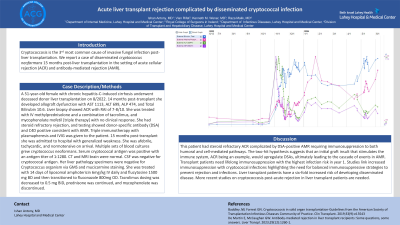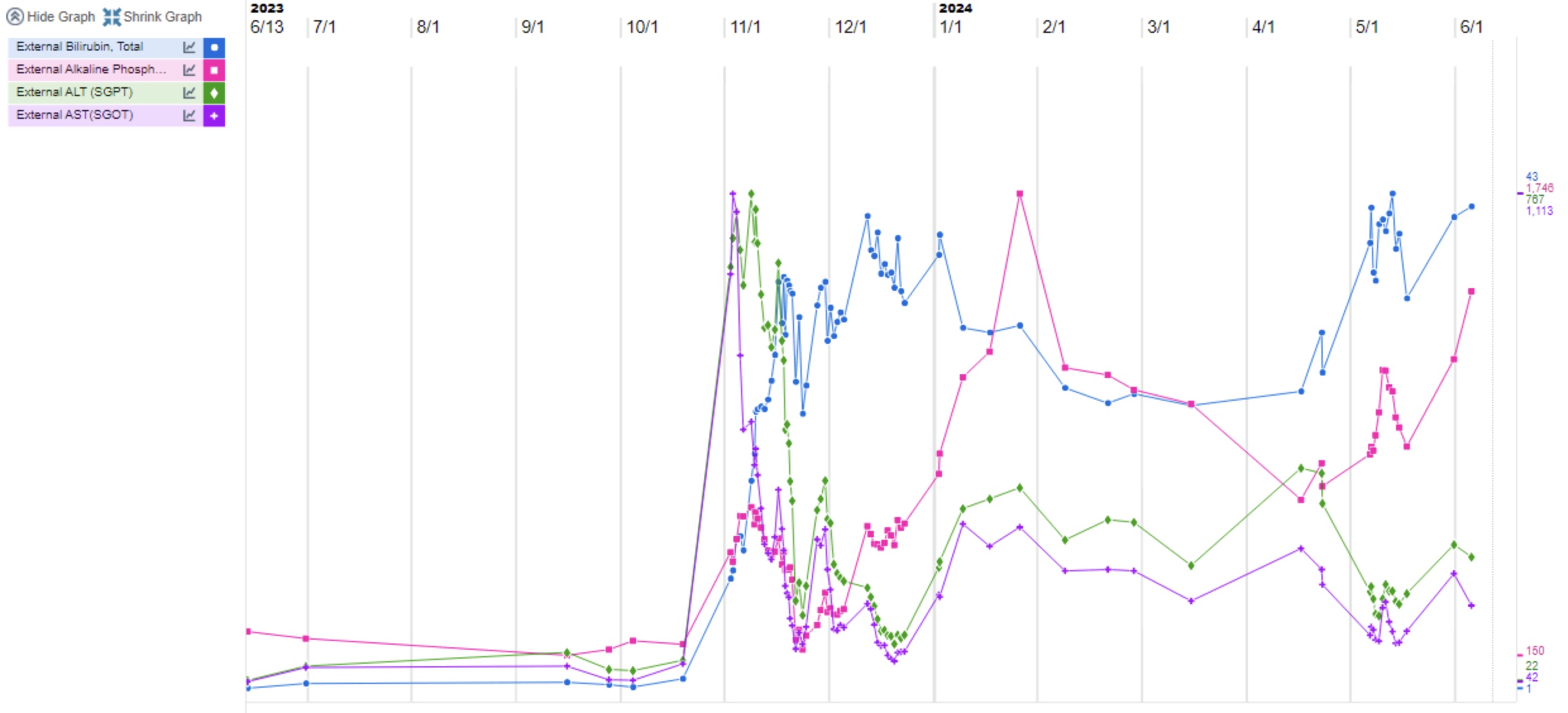Monday Poster Session
Category: Liver
P3093 - Acute Liver Transplant Rejection Complicated by Disseminated Cryptococcal Infection
Monday, October 28, 2024
10:30 AM - 4:00 PM ET
Location: Exhibit Hall E

Has Audio

Ishan Antony, MD
Lahey Hospital and Medical Center
Burlington, MA
Presenting Author(s)
Ishan Antony, MD1, Vian Rifat, 2, Kenneth M. Wener, MD1, Raza Malik, MD1
1Lahey Hospital and Medical Center, Burlington, MA; 2Royal College of Surgeons in Ireland, Dublin, Dublin, Ireland
Introduction: Cryptococcosis is the 3rd most common cause of invasive fungal infection post-liver transplantation. We report a case of disseminated cryptococcus neoformans 15 months post-liver transplantation in the setting of acute cellular rejection (ACR) and antibody-mediated rejection (AMR).
Case Description/Methods: A 51-year-old female with chronic hepatitis-C-induced cirrhosis underwent deceased donor liver transplantation on 8/2022. 14 months post-transplant she developed allograft dysfunction with AST 1113, ALT 699, ALP 474, and Total Bilirubin 10.6. Liver biopsy showed ACR with RAI of 7-8/10. She was treated with IV methylprednisolone and a combination of tacrolimus, and mycophenolate mofetil [triple therapy] with no clinical response. She had steroid refractory rejection, and testing showed donor-specific antibody (DSA) and C4D positive consistent with AMR. Triple immunotherapy with plasmapheresis and IVIG was given to the patient. 15 months post-transplant she was admitted to hospital with generalized weakness. She was afebrile, tachycardic, and normotensive on arrival. Multiple sets of blood cultures grew cryptococcus neoformans. Serum cryptococcal antigen was positive with an antigen titer of 1:1280. CT and MRI brain were normal. CSF was negative for cryptococcal antigen. Her liver pathology specimens were negative for Cryptococcus organism via GMS and mucicarmine staining. She was treated with 14 days of liposomal amphotericin 6mg/kg IV daily and flucytosine 1500 mg BD and then transitioned to fluconazole 800mg OD. Tacrolimus dosing was decreased to 0.5 mg BID, prednisone was continued, and mycophenolate was discontinued. Her liver function during the past year is charted in Figure 1.
Discussion: This patient had steroid refractory ACR complicated by DSA-positive AMR requiring immunosuppression to both humoral and cell-mediated pathways. The two-hit hypothesis suggests that an initial graft insult that stimulates the immune system, ACR being an example, would upregulate DSAs, ultimately leading to the cascade of events in AMR. Transplant patients need lifelong immunosuppression with the highest infection risk in year 1. Studies link increased immunosuppression with cryptococcal infections highlighting the need for balanced immunosuppressive strategies to prevent rejection and infections. Liver transplant patients have a six-fold increased risk of developing disseminated disease. More recent studies on cryptococcosis post-acute rejection in liver transplant patients are needed.

Disclosures:
Ishan Antony, MD1, Vian Rifat, 2, Kenneth M. Wener, MD1, Raza Malik, MD1. P3093 - Acute Liver Transplant Rejection Complicated by Disseminated Cryptococcal Infection, ACG 2024 Annual Scientific Meeting Abstracts. Philadelphia, PA: American College of Gastroenterology.
1Lahey Hospital and Medical Center, Burlington, MA; 2Royal College of Surgeons in Ireland, Dublin, Dublin, Ireland
Introduction: Cryptococcosis is the 3rd most common cause of invasive fungal infection post-liver transplantation. We report a case of disseminated cryptococcus neoformans 15 months post-liver transplantation in the setting of acute cellular rejection (ACR) and antibody-mediated rejection (AMR).
Case Description/Methods: A 51-year-old female with chronic hepatitis-C-induced cirrhosis underwent deceased donor liver transplantation on 8/2022. 14 months post-transplant she developed allograft dysfunction with AST 1113, ALT 699, ALP 474, and Total Bilirubin 10.6. Liver biopsy showed ACR with RAI of 7-8/10. She was treated with IV methylprednisolone and a combination of tacrolimus, and mycophenolate mofetil [triple therapy] with no clinical response. She had steroid refractory rejection, and testing showed donor-specific antibody (DSA) and C4D positive consistent with AMR. Triple immunotherapy with plasmapheresis and IVIG was given to the patient. 15 months post-transplant she was admitted to hospital with generalized weakness. She was afebrile, tachycardic, and normotensive on arrival. Multiple sets of blood cultures grew cryptococcus neoformans. Serum cryptococcal antigen was positive with an antigen titer of 1:1280. CT and MRI brain were normal. CSF was negative for cryptococcal antigen. Her liver pathology specimens were negative for Cryptococcus organism via GMS and mucicarmine staining. She was treated with 14 days of liposomal amphotericin 6mg/kg IV daily and flucytosine 1500 mg BD and then transitioned to fluconazole 800mg OD. Tacrolimus dosing was decreased to 0.5 mg BID, prednisone was continued, and mycophenolate was discontinued. Her liver function during the past year is charted in Figure 1.
Discussion: This patient had steroid refractory ACR complicated by DSA-positive AMR requiring immunosuppression to both humoral and cell-mediated pathways. The two-hit hypothesis suggests that an initial graft insult that stimulates the immune system, ACR being an example, would upregulate DSAs, ultimately leading to the cascade of events in AMR. Transplant patients need lifelong immunosuppression with the highest infection risk in year 1. Studies link increased immunosuppression with cryptococcal infections highlighting the need for balanced immunosuppressive strategies to prevent rejection and infections. Liver transplant patients have a six-fold increased risk of developing disseminated disease. More recent studies on cryptococcosis post-acute rejection in liver transplant patients are needed.

Figure: Figure 1: Patient's progression of liver function tests during ACR, AMR, and cryptococcal infection. ALT, alanine aminotransferase; AST, aspartate aminotransferase
Disclosures:
Ishan Antony indicated no relevant financial relationships.
Vian Rifat indicated no relevant financial relationships.
Kenneth Wener indicated no relevant financial relationships.
Raza Malik indicated no relevant financial relationships.
Ishan Antony, MD1, Vian Rifat, 2, Kenneth M. Wener, MD1, Raza Malik, MD1. P3093 - Acute Liver Transplant Rejection Complicated by Disseminated Cryptococcal Infection, ACG 2024 Annual Scientific Meeting Abstracts. Philadelphia, PA: American College of Gastroenterology.
